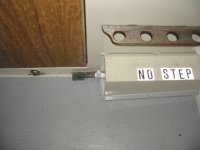granitecarver
New member
- Joined
- Jun 1, 2005
- Messages
- 6
- Reaction score
- 0
- C Dory Year
- 1985
- C Dory Model
- 22 Angler
- Vessel Name
- Acquitted
Hello All:
(1985 22' Angler)
1. My C-Dory will do anything but track straight ahead--one has to handle the helm every moment or it will fall off course and run away. I take it this is the effect of a flat bottom i.e, no 'V' which I'm accustomed to. Has anyone ever made a modification of some kind that makes these things track straighter? I love the boat except for this annoying and worrisome characteristic.
2. How do you bilge out the cockpit? There is a shallow depression adjacent to the transom drain-plugs but it's not deep enough to get a bilge-pump base submerged. What do others do about this?
Kind regards to all,
George
e-mail: granitecarver@gmail.com
(1985 22' Angler)
1. My C-Dory will do anything but track straight ahead--one has to handle the helm every moment or it will fall off course and run away. I take it this is the effect of a flat bottom i.e, no 'V' which I'm accustomed to. Has anyone ever made a modification of some kind that makes these things track straighter? I love the boat except for this annoying and worrisome characteristic.
2. How do you bilge out the cockpit? There is a shallow depression adjacent to the transom drain-plugs but it's not deep enough to get a bilge-pump base submerged. What do others do about this?
Kind regards to all,
George
e-mail: granitecarver@gmail.com

